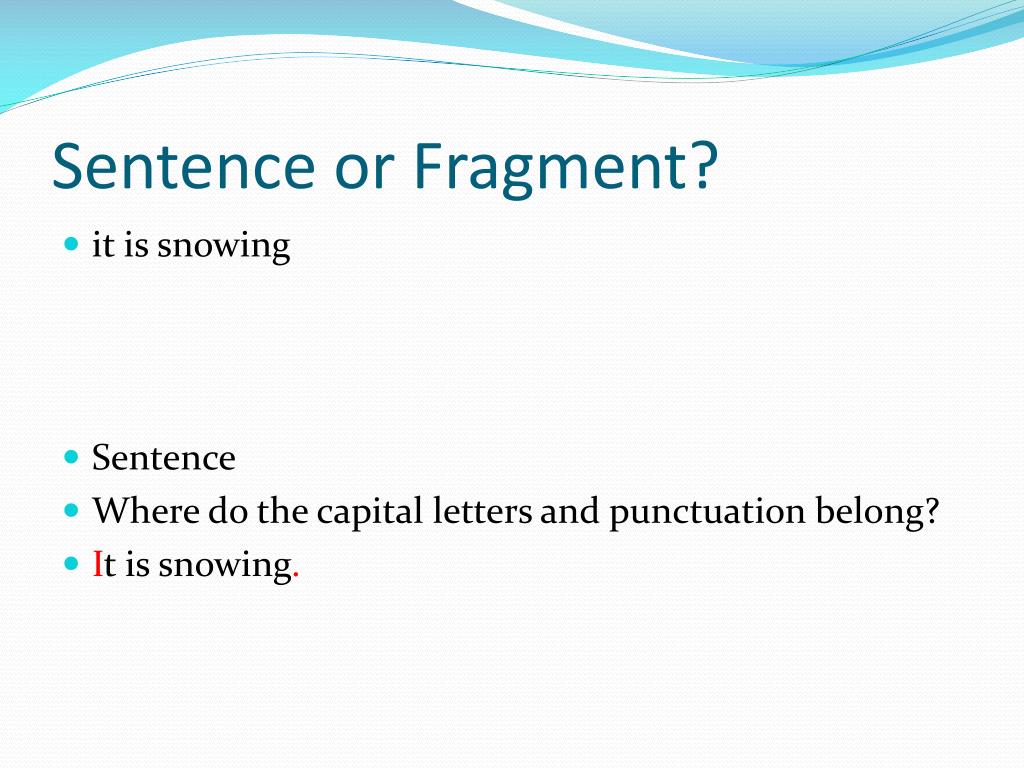

Side by Side Comparison – Sentence Fragment vs Run On in Tabular FormĪ sentence fragment is another name for an incomplete sentence. Similarities Between Sentence Fragment and Run Onĥ. Recognizing these elements is the first step in learning to identify sentence fragments and run-on sentences. A complete sentence has three main elements: a subject, a predicate and a complete thought (ability to stand alone). Sentence fragments and run on sentences are two of the most common errors most of us make in our writing. Check for each type of error separately, and look closely at each punctuation mark you use.The key difference between sentence fragment and run on is that a sentence fragment is a string of words that cannot form a complete thought on its own while a run on sentence is a sentence that is missing the right punctuation to make the sentence flow properly. The best way to locate fragment and run-on errors in your work is to read your writing out loud, slowly and carefully. If you add a comma alone, you will create a comma splice.)Įxample 9: Tom entered many writing contests, and he took first place in some of them.Įxample 10: Tom entered many writing contests he took first place in some of them. Add the appropriate punctuation and additional words, if necessary. It’s clear that this word group consists of two sentences “stuck” together without appropriate punctuation: Tom entered many writing contests and He took first place in some of them.ġ. Consider the following example:Įxample 8: Tom entered many writing contests he took first place in some of them. Some subordinating conjunctions are after, although, as, because, before, if, inasmuch, since, unless, until, when, whenever, whereas, and while.Įxample 7: Although Jane loves to cook, she also loves to go out to eat.ĭefinition: A fused sentence occurs when no punctuation at all is placed between two sentences.

Add a subordinating conjunction to one of the clauses. Notice that the “s” in she is lowercase after the semicolon.)ģ. (Semicolons should be placed between sentences that are related. She also loves to go out to eat.Įxample 6: Jane loves to cook she also loves to go out to eat. Replace the comma with a period, semicolon, or other appropriate punctuation.Įxample 5: Jane loves to cook. Leave the comma where it is and place an appropriate coordinating conjunction after it (and, but, for, nor, or, so, yet).Įxample 4: Jane loves to cook, and she also loves to go out to eat.Ģ.

Remember that a comma alone can never come between two sentences.ġ. Here, two sentences (Jane loves to cook and She also loves to go out to eat) are joined by a comma. Consider the following:Įxample 3: Jane loves to cook, she also loves to go out to eat. There are two types of run-on sentences: comma splices and fused sentences.ĭefinition: A comma splice occurs when only a comma is placed between two sentences. This is the best way to correct Example 1: He loves to travel too, which is why he decided to become a travel writer. Join the fragment to either the previous or next sentence (whichever one makes the most sense), using the correct punctuation. To correct it, add an appropriate subject: Joe was late. Here, the italicized word group is a fragment that is missing a subject. Add the missing subject, verb, or subject and verb.Įxample 2: Joe was late. Because fragments do not make sense out of context, they are easier to find if you read your work this way.įragments can be corrected in a couple of different ways:ġ. One surefire way to find fragments is to read your work from the last sentence to the first. It cannot “stand on its own” and make sense it is dependent upon the previous sentence for its meaning. The third word group, however, is not a sentence. Each contains a subject and a verb and expresses a complete thought. Notice that the first two word groups are, in fact, sentences. Which is why he decided to become a travel writer. Consider the following:Įxample 1: Peter has always loved to write. Another way of looking at it is that a fragment cannot “stand on its own” and make sense. Although a fragment is punctuated as a sentence, it is often missing a subject, a verb, or both. We know that a sentence must have at least one subject, at least one verb, and express a complete thought. What is a sentence fragment? A sentence fragment is an incomplete sentence.
DEFINITION OF FRAGMENT SENTENCE HOW TO
Here are some tips on how to recognize, correct, and even avoid fragments and run-on sentences. It is always helpful to have a proofreader, like those at Writer’s Relief, look over your creative writing before sending it out for publication.

Perhaps the most noticeable of these errors are sentence-structure errors-sentence fragments and run-on sentences. Nothing distracts your reader as much as grammatical errors, whether they be misplaced commas, dangling modifiers, or pronoun agreement problems.


 0 kommentar(er)
0 kommentar(er)
